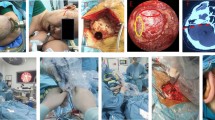Abstract
Background
Key hole surgery was recruited for MVD surgery since the maneuver is through the small space between the cerebellum and temporal/occipital bone. However, even small wounds can cause severe postoperative pain if there is significant tissue damage. Attention has been given to the size of the craniotomy rather than to the skin incision or soft tissues such as muscles.
Method
Suboccipital muscle dissection focusing on splitting the splenius capitis muscle was presented. The dura was reapproximated without additional dissection to harvest a fascia graft.
Conclusion
Muscle injury should be minimized to alleviate postoperative pain.




Similar content being viewed by others
References
Belykh E, Onaka NR, Zhao X, Cavallo C, Yağmurlu K, Lei T, Byvaltsev VA, Preul MC, Nakaji P (2018) Endoscopically assisted targeted keyhole retrosigmoid approaches for microvascular decompression: quantitative anatomic study. World Neurosurg 119:e1–e15. https://doi.org/10.1016/j.wneu.2018.1004.1218
Williams A, Newell RLM (2005) The back. In: Standring S (ed) Gray’s anatomy the anatomical basis of clinical practice 39th edition Elsevier Churchill Livingstone, Edinburgh London New York Oxford Philadelphia St Louis Sydney Tronto, pp 763
Hitotsumatsu T, Matsushima T, Inoue T (2003) Microvascular decompression for treatment of trigeminal neuralgia, hemifacial spasm, and glossopharyngeal neuralgia: three surgical approach variations: technical note. Neurosurgery 53:1436–1441; discussion 1442-1433. https://doi.org/10.1227/1401.neu.0000093431.0000043456.0000093433b
Huh R, Han IB, Moon JY, Chang JW, Chung SS (2008) Microvascular decompression for hemifacial spasm: analyses of operative complications in 1582 consecutive patients. Surg Neurol 69:153–157; discussion 157. https://doi.org/10.1016/j.surneu.2007.1007.1027
Jackson CG, McGrew BM, Forest JA, Hampf CR, Glasscock ME 3rd, Brandes JL, Hanson MB (2000) Comparison of postoperative headache after retrosigmoid approach: vestibular nerve section versus vestibular schwannoma resection. Am J Otolaryngol 21:412–416. https://doi.org/10.1016/s0196-0709(1000)80053-80058
McLaughlin MR, Jannetta PJ, Clyde BL, Subach BR, Comey CH, Resnick DK (1999) Microvascular decompression of cranial nerves: lessons learned after 4400 operations. J Neurosurg 90:1–8. https://doi.org/10.3171/jns.1999.3190.3171.0001
Nakahara Y, Matsushima T, Hiraishi T, Takao T, Funaki T, Masuoka J, Kawashima M (2013) Importance of awareness of the rhomboid lip in microvascular decompression surgery for hemifacial spasm. J Neurosurg 119:1038–1042. https://doi.org/10.3171/2013.1034.JNS121546
Rhoton AL Jr (2000) The cerebellopontine angle and posterior fossa cranial nerves by the retrosigmoid approach. Neurosurgery 47:S93–S129. https://doi.org/10.1097/00006123-200009001-200000013
Schaller B, Baumann A (2003) Headache after removal of vestibular schwannoma via the retrosigmoid approach: a long-term follow-up-study. Otolaryngol Head Neck Surg 128:387–395. https://doi.org/10.1067/mhn.2003.1104
Author information
Authors and Affiliations
Corresponding author
Ethics declarations
Ethics approval and consent to participate
The patient consented to the submission of the case report for submission to the journal.
Additional information
Summary of ten key points
1. Preoperative evaluation of the mastoid emissary canal and development of mastoid air cells on CT are important for appropriate craniotomy.
2. By using a slight S-shaped incision, the lateral part of the skin can be reflected to make the operative field slightly shallower even if the subcutaneous fat is thick.
3. The semispinalis capitis muscle is innervated by the posterior ramus of the cervical nerve more caudally, and splitting and minimal dissection of this muscle in the suboccipital area should cause minimal atrophy or pain.
4. The oblique superior muscle is divided.
5. To perform the craniotomy needed for this operation, the muscles on the medial side should be dissected further, while the digastric groove can be preserved with the digastric muscle.
6. A rather small craniotomy and the addition of drilling to the medial edge of the sigmoid sinus are safer, minimizing the risk of laceration of the sigmoid sinus.
7. An L-shaped dural incision along the sigmoid sinus and caudal bone edge keeps the dural flap moist and protects the cerebellum.
8. Even when the vertebral artery is concerned, the maneuver can be performed through the same corridor.
9. The wet dura can be approximated with shoe string sutures, and usually, no fascial graft is needed.
10. When a patch graft is needed to close the dura, the tendon of the sternocleidomastoid muscle can be recruited from the skin flap.
Publisher’s note
Springer Nature remains neutral with regard to jurisdictional claims in published maps and institutional affiliations.
This article is part of the Topical Collection on Functional Neurosurgery - Movement disorders
Supplementary Information
The video shows how to minimize muscle damage in detail (MOV 176210 kb).
Rights and permissions
About this article
Cite this article
Kimura, T. How I do it: minimizing muscle damage in microvascular decompression for hemifacial spasm. Acta Neurochir 163, 1045–1048 (2021). https://doi.org/10.1007/s00701-021-04726-1
Received:
Accepted:
Published:
Issue Date:
DOI: https://doi.org/10.1007/s00701-021-04726-1




